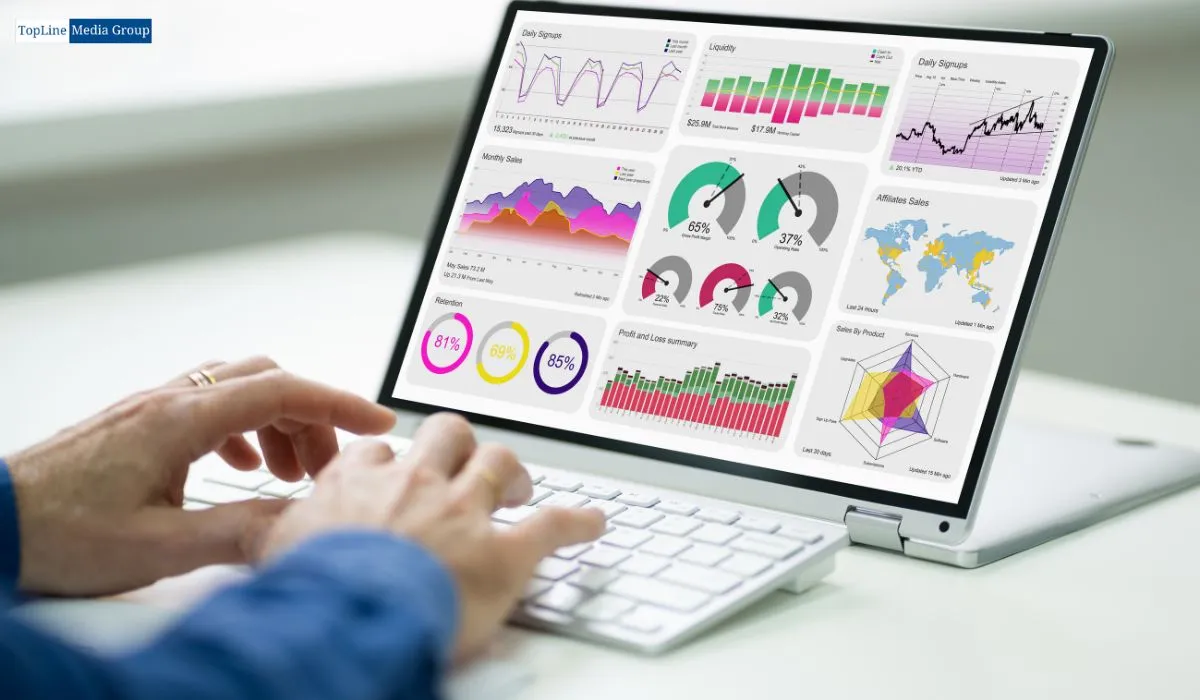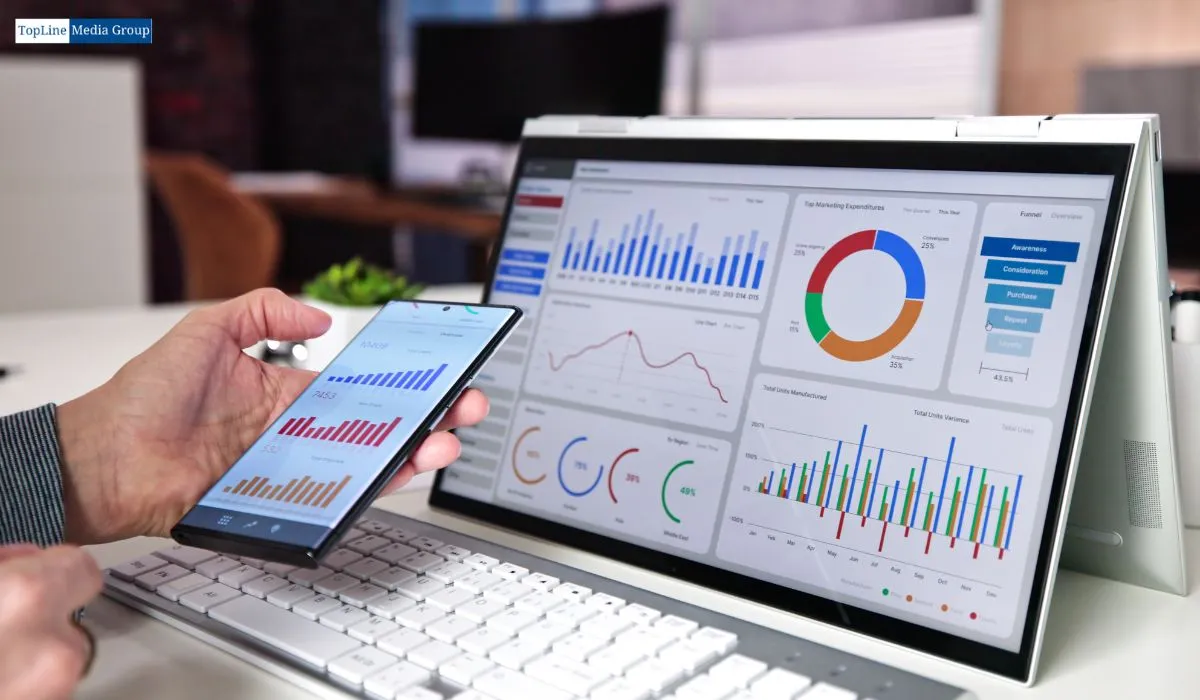Social media, in today’s fast-paced and rapidly changing digital landscape, has been a massive aspect of the marketing strategies of almost every business size.
So, billions of users across the globe can easily communicate with any brand through, among many others, the platforms of Facebook, Instagram, Twitter, and LinkedIn.
All these require that the companies tap powerful social media analytics tools to exploit the various opportunities that exist.
These track performance and give you insights into improvement of your marketing strategy and how you can boost your online presence.
Importance of Social Media Analytics
Get data-savvy to lift up that social media campaign.
Therefore, analysis of major social networks should be part of what constitutes your online strategy to give you impressive insights into audience preferences and behaviours.
Knowing what content works for them is critical to help compel engagements such as clicking “like,” sharing your posts, or saving them for later.
Once you gain all this information, you are able to create high-quality content that meets the needs of your target demographics.
In addition, with skills in social analytics, you are able to see if your marketing campaign is working.
That is, you get accurate statistics of how one can increase online followers.
However, unless one understands the elements of the process, one will not be able to implement good social media analytics.
Getting Started with Social Media Analytics
The first step on the way to understanding social media analytics is to understand what.
In short, it simply refers to the gathering, analyzing, and interpreting social media data.
That is to say, for all those who like simple concepts, the term social media analytics has to be what they want.
All of this is done for the purpose of making important discoveries that could be used toward any given end, such as tracking if the current strategy works or helping create a future social media plan.
What Is Social Media Analytics?
Social media analytics is a methodical process for tracking data points such as engagement, reach, and sentiment to evaluate marketing strategies or campaigns.
You will come across several vital terms when studying social media metrics:
Engagement: This measures the frequency by which your followers and other users discover your content with its likes, shares, or comments.
Reach: Those who have consumed your content are unique users, how many times your brand has been exposed on social media.
Sentiment Analysis: This measures the emotion that a comment or other writing may convey; therefore, it represents the attitudes and thoughts of your audience at scale.
Why Analytics are Essential on Social Media

Analyzing social media is essential for effective social media strategies.
Monitoring and measuring performance identifies strengths brands can improve, and decisions are made to enhance general performance.
These are some reasons why analytics is essential:
Content Optimization: Analytics shows the types of content that work for your audiences and keeps refining them continually.
Competitor Analysis: Monitoring what people are talking about from your competitors on social media will let you research trends in your industries and the successful strategies in place for them.
Audience Analysis: Analytics may be able to reveal vital information about your audience, letting you make more creative targeting and messaging.
Of course, without dedicated social media analytics tools, this is all but a pipe dream unless one wishes to sit down and rummage through spreadsheets of data.
Happily, most tools can automatically do lots of this work so that it is less intimidating.
Overview of Social Media Analytics Tools
Most marketing teams use social media analytics tools to inform the strategy and streamline daily operations.
Generally speaking, this choice would depend on the specific business needs and budget issues.
Of course, here are a few popular options:
Google Analytics: This is a free solution for most businesses. Google Analytics will provide many insights into what is happening regarding web traffic and audience.
Built-in Platform Analytics: Major social media platforms like Facebook and Instagram offer built-in analytics that provide insights into the audience’s demographics and how content performs.
Paid Analytics Tools: Specific tools are designed to analyze and monitor social media activities, offering actionable insights like Brandwatch, Sprout Social, and Hootsuite Analytics.
Comparison of Social Media Analytics Tools
Among the many prominent social media analytics tools available in the market, the following seem to stand out:
Brandwatch: A subscription-based tool offering advanced capabilities in social listening as it tracks the brand and, consequently, analyzes the conversation at scale.
It does deep-level sentiment analysis and gleans actionable insights, including performance tracking for specific keywords and hashtags.
Google Analytics: It’s a free tool that serves comprehensive web traffic analysis and insight into the audience visiting or converting through the website.
It also serves ideal business services, starting with social media analytics.
Sprout Social: A more paid tool with advanced social analytics, including comparative analysis and automatic reporting.
Hootsuite Analytics: Famous for post-performance statistics and team tracking, Hootsuite knows how the audience interacts with your target audience.
Each tool has strengths; therefore, the choice will depend on your requirements and budget.
Integration with Social Media Management Tools
Many social media analytic tools are easy to integrate with traditional social media management tools, meaning there’s less work for you to do daily.
Here are some examples:
Meta Business Suite (formerly Facebook Business Suite): This tool puts together management for Facebook, Instagram, and WhatsApp under one roof so you can look at your analytics data in the same place.
Brandwatch, Hootsuite, and Sprout Social: These are a few of the tools that allow you to merge different social platforms while streamlining analytics efforts.
Creating a Social Media Strategy with Analytics
While analytics from social media is meaningful, posting consistently across all channels is integral.
To this end, a good marketing strategy is a must.
Strategy in Line with Business Objectives
However, before you actually launch your social media campaign, you would want to know if it meets with your overall business goals.
Based on your analytics, you will also be able to outline the objectives that your marketing campaign may even include brand awareness, sales, or customer engagement.
Therefore, you can set realistic goals for the campaigns going ahead using the conclusion of past successes.
Setting the Right Social Media Channels
Analytics can help you also identify the most beneficial social media sites.
Start by placing the target audience and knowing which platform your audience spends most of their time on.
For example:
Facebook is very efficient when you want to reach many varied audiences because it uses features like Pages, Groups, or Ads.
Instagram is the platform for visual content to better communicate an aesthetically oriented brand identity.
TikTok is ideal for younger audiences who are utilizing short-form video content.
LinkedIn: Good for sharing B2B content or a company’s news.
Knowing the demographics of each will help you determine the proper channels for your overall strategy.
Rolling Out and Maintaining Social Media Campaigns
Once the social media strategy has been prepared, it is possible to launch campaigns.
There are several steps that you have to follow:
Content Planning and Scheduling
Campaign objectives, your target audience, and what content you want to post should all be considered before posting.
Use a social media management tool to plan posts, stay in a rhythm of posting, and target the best posting times for engagement.
Monitor and Respond to Engagement
As your campaign is ongoing, you must be monitoring the engagement rates.
Track key performance metrics around likes, shares, comments, and even conversions to get a measure of how successful this undertaking has been.
Notably, engagement is paramount in connecting with your audience-crucial for amplifying efforts on social media.
Influencer Campaigns and Collaborations
Integrating influencer campaigns can amplify the impact of your marketing.
You can expand your coverage and engage your audience further with the help of influencers.
Besides, you can also identify through analytics which influencers are discussing your target demographic; you then look for influencers who have a track record of good collaboration with successful partners.
Reporting and Insights
Once live, gather data and convert it into actionable reports and dashboards.
Custom Reports and Dashboards
Custom reports will focus you on metrics that matter to your specific goals.
Most social media analytics tools can collect data from multiple platforms in one place, making the process much more accessible for assessing your performance.
Create customized dashboards, and you can easily highlight the information that matters most.
You can also easily share it with your team or clients.
Using Past Data for Strategic Planning
Once again, that is the beauty of examining history-it receives assistance in informing future strategy based on marketing actions.
For example, I would be able to set realistic goals by comparing performance between periods; for example, year over year or quarter over quarter and flag potential performance issues.
Identifying past campaign milestones can provide insight into effective strategies.
Social media reports will inform you of your brand and offer a source of competitor research.
Comparing pertinent KPIs from you and your competitors may help tag spaces for probable improvement.
Content themes and posting patterns must be compared to inform and position your social media strategy while capitalizing on your brand’s strengths.
Optimising Social Media Presence
Now that you have insights from your analytics, it’s time to implement all this knowledge.
Here’s the step-by-step guide for maximizing your social media analytics:
Content Adjustments Based on Data
You might as well just continue doing stuff unless you implement some changes to the content of that analysis, so analyzing your social media’s performance is a pointless exercise.
Metrics will report what works for your audience, so listen to post timing, content types, and engagement rates.
Use this insight as the foundation to formulate strategies for your marketing teams and your social media managers as you seek to devise effective strategies for different media.
Growth Strategies for Follower Growth
Most expansion into social media marketing aims to increase the number of followers, which leads to increased engagement and viewability by the target audience.
By analyzing the analytics, you can establish the best time to post for your audience and which content to share will result in the most engagement.
Because each platform is unique, your strategies should account for those differences to increase the number of followers in that area.
Challenges and Considerations in Social Media Analytics
As you wade through this new world of social media analytics, beware because you might also face challenges.
Here are some common challenges and ways to handle them:
Dealing with Data Privacy and Compliance
Because social media analytics software has in-built measures for data privacy, it would also require you to update on issues related to compliance.
Data privacy laws and regulations, such as GDPR and CCPA, will let you know how they could help your business safeguard itself and continue to earn customer trust.
Reduced Information Overload
Given the vast amounts of data circulating, it sometimes gets confusing whether it’s noise or action information, so focus on the right KPIs that matter most about your aim and use the same driving forces for your decisions.
Validated Reporting
Bad data leads to wrong strategies.
Analytics tools must be correctly configured to track essential metrics for business needs.
Also, make sure you cross-check your data sources to validate their reliability.
Algorithm Update Adaptation
A change in social media algorithm often impacts its viewership; adapt to changes and constantly update your strategies according to the new moves for success to continue.
Conclusion
Analytics tools on social media are very important to a company, especially to those that want to diversify their marketing in a way that empowers them to succeed.
Data-driven insights mean informed decisions, optimum utilization of content strategies, and added depth for the presence of companies on the web.
Welcome the power of analytics and see your brand bloom amidst the cutthroat web landscape.
FAQs
What are social media analytics tools, and why might a business care?
Social analytics are software applications for gathering, filtering, analyzing, and interpreting data coming from the social media outlet.These help businesses track engagement, reach, audience demographics, and content performance. Therefore, these tools become very important because of the insights that allow businesses to make data-driven decisions, optimize marketing strategies, and better understand audiences’ preferences. Analytics helps companies refine their content to increase customer engagement and boost sales.
How do I choose the best social media analytics solution for my business?
Based on several criteria, the ideal social media analytics solution for your business depends on its goals, whether it fits your budget, and any other constraints relating to specific features you need. Start with what key metrics you want to track (e.g., engagement, reach, conversions). Consider those solutions that have the most commonly used social media platforms integrated. The popular ones include Google Analytics in tracking website traffic; you will find that Sprout Social offers comprehensive analytics, and Ho, suite is perfect for managing multiple accounts. Use free trials as an opportunity to assess the usability and effectiveness of each before finalizing a choice.
What key metrics would I want to keep track of when analyzing my social media performance?
A few essential vital metrics explain the performance and behaviour of your audience about the effect of your content on social media. The critical metrics for analysis on engagement rate measure how well your audience interacts with your content, including likes, shares, comments, and clicks. Reach and impressions will show the reach of unique users who might have seen it and impressions of how often your content is displayed.
Follower Growth: This refers to the number of followers tuned into you over time and depicts whether people are interested in your brand.
Conversion Rate: This measures the number of people that took the desired action you wanted them to after seeing the social media content.
How do I leverage social media analytics to improve my content strategy?
With social media analytics, you can take your content strategy to a whole new level because you will fully understand what drives the most action within your audience. You will be able to identify which posts are compelling, so to speak, and which content formats get people engaging and interacting, whether it is the different picture types, video types, or polls. Additionally, analytics can pinpoint peak hours when posting messages, which is more likely to attract more people. Use this data to fine-tune content themes, messages, and formats for growing engagement and outreach.
What might I face or experience while using analytics tools for social media?
While the information offered by social media analytics tools is beneficial in understanding the efforts, the users may also face a few challenges, such as information overload and missay reporting while crossing the limits of privacy regulation. Data overload emanates from analyzing large amounts of information without a critical metric. Proper set up and monitoring of analytics tools for ensuring the correctness of data are involved. Data protection laws like GDPR and CCPA concerning user information are very important to ensure compliance and protect user data while maintaining trust. Updating strategies that help review your analytics process and mitigate problems can be crucial.
How often should I review my social media analytics?
The frequency of reviewing your social media analytics depends on your business goals and the speed of your marketing campaigns. For repetitive-type campaigns, an analyst must review analytics by week to track performance and make it right in time. To analyze trends, assess the effectiveness of content, evaluate an overall strategy, and review analytics by month. Aside from that, a more detailed quarter analysis would enable one to analyze performance based on even longer terms and perfect adjustments to the overall social media approach with the correct information.




